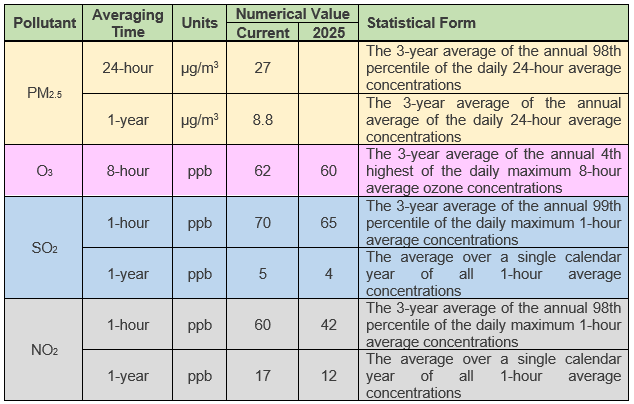
Canadians enjoy a good level of outdoor air quality. Emissions of air pollutants that cause smog and acid rain have decreased significantly during the past decades. These reductions have contributed to the reduction of the air pollutants that Canadians breathe every day – pollutants that can contribute to health issues such as asthma and cardiovascular diseases. According to the World Health Organization (WHO) air pollution represents the biggest environmental risk to human health and can severely affect the environment. Even at low levels, air pollution has been clearly linked to increased heart and breathing problems, increased hospitalization and emergency room visits and premature death.
Canadians living in heavily populated and industrialized areas of the country may be exposed to potentially harmful levels of outdoor air pollutants, at concentrations that exceeded established standards. Improved air quality reduces heart attacks and hospital visits, avoids hundreds of thousands of child asthma attacks, and prevents millions of lost school and work days in Canada alone. The majority of pollutants come from human activities, such as transportation, the burning of fuels for electricity and heating, and industry. Natural sources such as forest fires can sometimes be substantial.
In order to keep a check on the drastic pollution levels, the federal government in the year 2012 published the Canadian Ambient Air Quality Standards (CAAQS) as non-binding objectives under the Canadian Environmental Protection Act. The purpose of the CAAQS is to drive continuous improvement in air quality. The concentrations of particles measured at a monitoring station calculated in the statistical form of a standard are referred to as CAAQS metric values shows them for PM2.5 and ozone.
The initial Standards were set to monitor the pollution levels for Particular Matter 2.5 and Ozone in the year 2012. In the late years they were redesigned to provide a uniform measure of protection for human health and the environment across the country by establishing new ambient air quality standards for fine particulate matter (PM2.5), ozone (O3), sulphur dioxide (SO2), and nitrogen dioxide (NO2). All levels of government will be expected to work together to achieve the CAAQS.
Let’s see what the harsh effects are of the above-mentioned gases on health and environment and on what bases the standards are set to control their emissions and effects.
- Ozone
- Exposure to ozone can reduce the volume of air that the lungs breathe in and cause shortness of breath. Ozone in sufficient doses increases the permeability of lung cells, rendering them more susceptible to toxins and microorganisms.
- Ozone exposure reduces the plants’ ability to photosynthesize and produce their own food. Plants respond by growing more leaves thereby reducing the amounts of stored carbohydrates in roots and stems. This weakens plants, making them susceptible to disease, pests, cold and drought. Ozone also reduces crop and timber yields, resulting in millions of dollars in economic losses.
- Ozone can cause substantial damage to a variety of materials such as rubber, plastics, fabrics, paint and metals. Exposure to ozone progressively damages both the functional and aesthetic qualities of materials and products, and shortens their life spans.
- Fine particulate matter (2.5)
- Particle pollution refers to a mix of tiny solid and liquid particles that are in the air we breathe. Many of the particles are so small as to be invisible, but when levels are high, the air becomes opaque. Because of their size, you cannot see the individual particles. You can only see the haze that forms when millions of particles blur the spread of sunlight.
- Particle pollution can be very dangerous to breathe depending on the level. Breathing particle pollution may trigger illness, hospitalization and premature death and other health risks.
- PM can stain and damage stone and other materials, including culturally important objects such as statues and monuments.
- Particles can be carried over long distances by wind and then settle on ground or water making lakes and streams acidic and depleting the nutrients in soil thus affecting the diversity of ecosystems.
- Sulphur dioxide
- Sulphur dioxide (SO2), a foul-smelling toxic gas, is part of a larger group of chemicals called sulphur oxides. These gases, especially SO2, are emitted by the burning of fossil fuels or other materials that contain sulphur.
- Acid rain can damage trees and plants, inhibit plant growth, and damage sensitive ecosystems and waterways. Sulphur dioxide also contributes to the formation of thick haze and smog.
- It also can contribute to respiratory illness and aggravate existing heart and lung conditions.
- Nitrogen dioxide
- Nitrogen dioxide does significant damage to the respiratory system over time. In areas affected by smog, symptoms including coughing and throat and chest irritation commonly develop.
- It has also been theorized to increase lung cancer risk in those exposed to high levels of pollutants from fuel burning. All of these—asthma, allergies, and cancer—are some of the more understood health risks.
- There are also ways nitrogen dioxide damages natural life. Acid rain decreases crop yields because the soil becomes acidic, and existing crops can’t flourish. Acidic products can even deposit without water’s involvement—buildings experience gradual deterioration due to the build-up of acid on their surfaces.
The CAAQS can be understood with the following table:

Certain air pollutants influence the climate, cause negative processes in the protective ozone layer and contribute to the greenhouse effect. Therefore, it is important to protect the air by taking actions to ensure its best possible quality. The development of air quality policies was analysed, and these legislations were implemented. Although we have achieved significant improvements in air quality, it’s management still requires a more integrated and ambitious approach.

